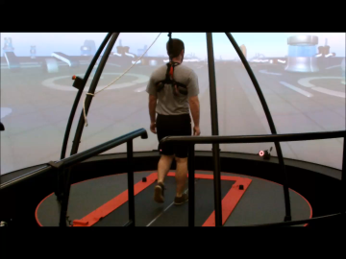July 10, 2020
Research report: Gait Perturbation Research using the CAREN
 Dr. Christopher McCrum, Assistant Professor, Maastricht University, Maastricht, The Netherlands
Dr. Christopher McCrum, Assistant Professor, Maastricht University, Maastricht, The Netherlands
Use it or lose it! Or is it lose it to improve it? For improving reactive balance, the latter seems to be the case! The ability to apply controlled mechanical perturbations to gait allows a task specific approach to understanding and improving balance and falls risk, as we have been investigating in Maastricht the last few years. In this report, I will give an overview of my PhD research using the CAREN Extended.
Falls and their consequences present a persistent and growing challenge to our ageing populations. As a result, there is a wealth of research on fall prevention. One subfield within this research is the use of controlled, mechanical perturbations to either study reactive balance control in the lab in a “realistic” manner, or for the purpose of studying or triggering training effects. This research has been rapidly developing over the last 20 years, in part due to improvements in, and availability of technology for applying these perturbations. Over the last 5 years, as part of my PhD project (1), we aimed to gain more detailed understanding of the stability and adaptation of gait during such mechanical perturbations that may help improve the effectiveness of interventions for falls reduction, by identifying specific mechanisms of gait adaptation that can be exploited. We also wanted to further our understanding of how old age might affect gait stability and adaptability, with the perspective that this knowledge could improve the effectiveness and specificity of exercise-based falls reduction interventions for both healthy and clinical populations at an increased risk of falls.
Early in the project, we conducted a systematic review of gait perturbation methods and protocols that had been previously used with older adults (2). One advantage of treadmill systems like the CAREN that we identified, was that the timing and location of perturbations is more easily disguised, if desired, compared to overground setups where participants might quickly learn and be able to anticipate the perturbations. One other issue that we identified was the limited consideration that had been given to how walking speed could affect both the response to perturbations and the measurement of stability. We subsequently developed a method to help address this, which we called the “stability-normalised walking speed” (3). This allowed us to prescribe walking speeds for our participants that would result in approximately equivalent margins of stability, negating some of the undesirable effects of walking speed in our later results.
We then conducted studies looking at how both young and older adults adapt their stability following repeated perturbations. We aimed to examine how young adults adapt, retain and transfer adaptations in gait stability to controlled gait perturbations and whether or not the processes of adaptation and transfer are altered in older adults. To do this, we applied the perturbations as shown in the figure (adapted from McCrum et al. (5)) using a customized version of the perturbations application in the D-Flow software of the CAREN. The right leg (R) was perturbed by a treadmill belt acceleration first (pert1R), followed by eight perturbations (pert2L – pert9L) to the left leg (L), and the final perturbation (pert10R) was again applied to the right leg (R).

We found that the relationship between walking speed and stability varies from person to person in both young and older adults, confirming the need for the stability-normalised walking speed when looking to compare groups in a more accurate manner. We also found that older adults demonstrated interlimb transfer of adaptations (improved balance recovery following a perturbation to the “untrained” leg after a sequence of repeated perturbations to the other “trained” leg) to sudden perturbations when younger adults did not (4, 5). We think this might be related to the “need” for adjustment in the older adults, who may be performing closer to their maximum capacities in such tasks, but this remains a question for future research.
Overall, the work conducted within my PhD project has highlighted that treadmill technology such as the CAREN can improve the validity of perturbation research, can provide short, effective adaptation and training protocols, and that such technology may also represent effective and feasible options for perturbation-based balance training (6).
Our research on this topic continues with our CAREN Extended at Maastricht University Medical Centre+, with ongoing studies looking into both mechanistic and clinical questions related to perturbation assessment and training. For more insight into the research described, the video of my PhD defence can be found here: https://youtu.be/sCpRIlmALYI and a PDF of my thesis can be downloaded here: https://doi.org/10.26481/dis.20191219cm
References
- McCrum C. A Trip to Remember: Assessing and Improving Walking Stability in Older Adults Gildeprint Drukkerijen, 2019. 256 p. doi: 10.26481/dis.20191219cm
- McCrum C, Gerards MHG, Karamanidis K, Zijlstra W, Meijer K. A systematic review of gait perturbation paradigms for improving reactive stepping responses and falls risk among healthy older adults. Eur Rev Aging Phys Act. 2017;14(1):3. doi: 10.1186/s11556-017-0173-7
- McCrum C, Willems P, Karamanidis K, Meijer K. Stability-normalised walking speed: A new approach for human gait perturbation research. J Biomech. 2019;87:48-53. doi: 10.1016/j.jbiomech.2019.02.016
- McCrum C, Karamanidis K, Grevendonk L, Zijlstra W, Meijer K. Older adults demonstrate interlimb transfer of reactive gait adaptations to repeated unpredictable gait perturbations. GeroScience. 2020;42(1):39-49. doi: 10.1007/s11357-019-00130-x
- McCrum C, Karamanidis K, Willems P, Zijlstra W, Meijer K. Retention, savings and interlimb transfer of reactive gait adaptations in humans following unexpected perturbations. Commun Biol. 2018;1(1):230. doi: 10.1038/s42003-018-0238-9
- Gerards MHG, McCrum C, Mansfield A, Meijer K. Perturbation-based balance training for falls reduction among older adults: Current evidence and implications for clinical practice. Geriatr & Gerontol Int. 2017;17(12):2294-303. doi: 10.1111/ggi.13082


